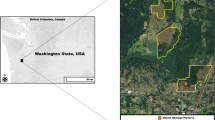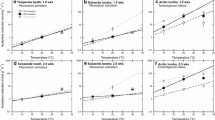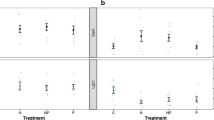Abstract
Background and aims
Nitrogen (N2) fixation in feather moss-cyanobacteria associations is a major source of N for boreal ecosystems. However, mosses experience significant shifts in their moisture status due to daily and yearly fluctuations in sunlight, temperature and precipitation. While the effects of drying and rewetting on nutrient leaching and photosynthesis in mosses have been studied, no attempt has been made to assess the consequences for N2 fixation in feather mosses.
Methods
We conducted an experiment in which we dried (3 day at 28 °C; <9 % of field moisture) and rewetted samples of the feather moss Pleurozium schreberi (Brid.) Mitt. that is colonized by N2-fixing-cyanobacteria to assess the influence on N2 fixation. Further, we tested how long it takes for N2 fixation to recover from a drying-rewetting cycle. In addition, we assessed how N2 fixation changes with incubation time with acetylene (2–65 h).
Results
A drying period of 3 days almost completely eliminated N2 fixation (<0.2 μmol m−2 h−1) in the moss. However, rates slowly recovered after rewetting, reaching N2 fixation levels of moist (non-water stressed) moss 5 days after rewetting. Nitrogen fixation increased significantly with incubation time with acetylene (0 μmol m−2 h−1 at 2 h vs. 26 μmol m−2 h−1 at 65 h incubation).
Conclusions
Although N2 fixation recommenced upon rewetting, the recovery was slow. Thus, recurrent drying and rewetting cycles could reduce total N2 fixation in moss-cyanobacteria associations over time, leading to reduced total N input to the system.


Similar content being viewed by others
References
Ackermann K, Zackrisson O, Rousk J, Jones DL, DeLuca TH (2012) N2 fixation in feather mosses is a sensitive indicator of N deposition in boreal forests. Ecosystems 15:986–998
Bay G, Nahar N, Oubre M, Whitehouse MJ, Wardle DA, Zackrisson O, Nilsson MC, Rasmussen U (2013) Boreal feather mosses secrete chemical signals to gain nitrogen. New Phytol. doi:10.1111/nph.12403
Belnap J (2001) Factors influencing nitrogen fixation and nitrogen release in biological soil crusts. In: Belnap J, Lange OL (eds) Biological soil crusts: structure, function, and management. Springer, Berlin-Heidelberg, pp 241–261
Carleton TJ, Read DJ (1991) Ectomycorrhizas and nutrient transfer in conifer-feather moss ecosystems. Can J Bot 69:778–785
DeLuca TH, Zackrisson O, Nilsson MC, Sellstedt A (2002a) Quantifying nitrogen-fixation in feather moss carpets of boreal forests. Nature 419:917–920
DeLuca TH, Nilsson MC, Zackrisson O (2002b) Nitrogen mineralization and phenol accumulation along a fire chronosequence in northern Sweden. Oecologia 133:206–214
DeLuca TH, Zackrisson O, Gundale MJ, Nilsson MC (2008) Ecosystem feedbacks and nitrogen fixation in boreal forests. Science 320:1181
Dilworth MJ (1966) Acetylene reduction by nitrogen-fixing preparations from Clostridium pasteuriunum. Biochim Biophys Acta 127:285–294
Gentili F, Nilsson MC, Zackrisson O, DeLuca TH, Sellstedt A (2005) Physiological and molecular diversity of feather moss associative N2 -fixing cyanobacteria. J Exp Bot 56:3121–3127
Glime JM (2007) Bryophyte ecology, volume 1 physiological ecology. Ebook sponsored by Michigan Technological University and the International Association of Bryologists
Gundale MJ, Gustafsson H, Nilsson MC (2009) The sensitivity of nitrogen fixation by a feathermoss–cyanobacteria association to litter and moisture variability in young and old boreal forest. Can J For Res 39:2542–2549
Gundale MJ, DeLuca TH, Nordin A (2011) Bryophytes attenuate anthropogenic nitrogen inputs in boreal forests. Glob Chang Biol 17:2743–2753
Gundale MJ, Wardle DA, Nilsson MC (2012) The effect of altered macroclimate on N-fixation by boreal feather mosses. Biol Lett 8:805–808
Hardy RWF, Burns RC, Holsten RD (1973) Applications of the acetylene-ethylene assay for measurement of nitrogen fixation. Soil Biol Biochem 5:47–81
Hawes I, Howard-Williams C, Vincent WF (1992) Desiccation and recovery of Antarctic cyanobacterial mats. Polar Biol 12:587–594
Herrnstadt I, Kidron GJ (2005) Reproductive strategies of Bryum dunense in three microhabitats in the Negev desert. Bryologist 108:101–109
Houlton BZ, Wang YP, Vitousek PM, Field CB (2008) A unifying framework for dinitrogen fixation in the terrestrial biosphere. Nature 454:327–331
Ininbergs K, Bay G, Rasmussen U, Wardle DA, Nilsson MC (2011) Composition and diversity of nifH genes of nitrogen-fixing cyanobacteria associated with boreal forest feather mosses. New Phytol 192:507–517
Jackson BG, Martin P, Nilsson MC, Wardle DA (2011) Response of feather moss associated N2 fixation and litter decomposition to variations in simulated rainfall intensity and frequency. Oikos 120:570–581
Kaplan-Levy RN, Hadas O, Summers ML, Rücker J, Sukenik A (2010) Akinetes: dormant cells of cyanobacteria. In: E Lubzens et al. (ed) Dormancy and resistance in harsh environments, Topics in Current Genetics 21:5–27
Kidron GJ, Herrnstadt I, Barzilay E (2002) The role of dew as a moisture source for sand microbiotic crusts in the Negev desert, Israel. J Arid Environ 52:517–533
Lange OL, Kilian E, Ziegler H (1986) Water vapor uptake and photosynthesis of lichens: performance differences in species with green and blue-green algae as phycobionts. Oecologia 71:104–110
Lange OL, Belnap J, Reichenberger H (1998) Photosynthesis of the cyanobacterial soil-crust lichen Collema tenax from arid lands in southern Utah, USA: responses of CO2 exchange. Funct Ecol 12:195–202
Leppänen SM, Salemaa M, Smolander A, Mäkipää R, Tiirola M (2013) Nitrogen fixation and methanotrophy in forest mosses along a N deposition gradient. Environ Exp Bot 90:62–69
Oechel WC, Van Cleve K (1986) In: Van Cleve K, Chapin FS, Flanagan PW, Viereck LA, Dyrness CT (eds) Forest ecosystems in the Alaskan Taiga: a synthesis of structure and function. Springer, New York, pp 121–137
Oliver MJ, Bewley JD (1984) Plant desiccation and protein synthesis. IV. RNA synthesis, stability, and recruitment of RNA into protein synthesis during desiccation and rehydration of the desiccation-tolerant moss, Tortula ruralis. Plant Physiol 74:21–25
Proctor MCF (2001) Patterns of desiccation tolerance and recovery in bryophytes. Plant Growth Regul 35:147–156
Proctor MCF, Oliver MJ, Wood AJ, Alpert P, Stark LR, Cleavitt NL, Mishler BD (2007) Desiccation tolerance in bryophytes: a review. Bryologist 110:595–621
R Development Core Team (2011) R: a language and environment for statistical computing. R Foundation for Statistical Computing, Vienna, Austria. ISBN 3-900051-07-0. http://www.R-project.org
Rousk K, Jones DL, DeLuca TH (2013) Exposure to nitrogen does not eliminate N2 fixation in the feather moss Pleurozium schreberi (Brid.) Mitt. Plant Soil. doi:10.1007/s11104-013-1908-5
Satoh K, Hirai M, Nishio J, Yamaji T, Kashino Y, Koike H (2002) Recovery of photosynthetic systems during rewetting is quite rapid in a terrestrial cyanobacterium, Nostoc commune. Plant Cell Physiol 43:170–176
Scherer S, Zhong ZP (1991) Desiccation independence of terrestrial nostoc commune ecotypes (Cyanobacteria). Microb Ecol 22:271–283
Scherer S, Ernst A, Chen TW, Böger P (1984) Rewetting of drought-resistant blue-green algae: time course of water uptake and reappearance of respiration, photosynthesis, and nitrogen fixation. Oecologia 62:418–423
Schöllhorn R, Burris RH (1967) Acetylene as a competitive inhibitor of NP fixation. Proc Natl Acad Sci 58:213–216
Smith VR (1984) Effects of abiotic factors on acetylene reduction by cyanobacteria epiphytic on moss at a Subantarctic Island. Appl Environ Microbiol 48:594–600
Staal M, te Lintel-Hekkert S, Harren F, Stal L (2001) Nitrogenase activity in cyanobacteria measured by the acetylene reduction assay: a comparison between batch incubation and on-line monitoring. Environ Microbiol 3:343–351
Startsev NA, Lieffers VJ (2002) Dynamics of mineral nitrogen released from feathermosses after dehydration or handling stress. Bryologist 109:551–559
Stewart KJ, Lamb EG, Coxson DS, Siciliano SD (2011) Bryophyte-cyanobacterial associations as a key factor in N2-fixation across the Canadian Arctic. Plant Soil 344:335–346
Turetsky MR (2003) Bryophytes in carbon and nitrogen cycling. Invited essay for new frontiers in bryology and lichenology. Bryologist 106:395–409
Wilson JA, Coxson DS (1999) Carbon flux in a subalpine spruce-fir forest: pulse release from Hylocomium splendens feather-moss mats. Can J Bot 77:564–569
Zackrisson O, Nilsson MC, Wardle DA (1996) Key ecological role of charcoal from wildfire in the Boreal forest. Oikos 77:10–19
Zackrisson O, DeLuca TH, Nilsson MC, Sellstedt A, Berglund LM (2004) Nitrogen fixation increases with successional age in boreal forests. Ecology 85:3327–3334
Acknowledgments
We thank Dr. J. Rousk for assistance in the laboratory. K. Rousk was funded through the 125th Anniversary Scholarship, Bangor University. Additional travel and analytic support was made available through NERC (grant no. NE/I027150/1).
Author information
Authors and Affiliations
Corresponding author
Additional information
Responsible Editor: Katharina Pawlowski.
Electronic supplementary material
Below is the link to the electronic supplementary material.
Fig. S1
Cumulative N2 fixation (nmol acetylene reduced g−1 DW) in Pleurozium schreberi measured at different times (2–65 h) of incubation with acetylene. Power Fit equation and r-value are given. Shown are means ±SE. Error bars are sometimes hidden behind symbols. (DOCX 212 kb)
Table S2
Mean acetylene reduction rates ±SE (μmol m−2 h−1) in the constantly moist moss and the dried-rewet moss prior drying and immediately after drying before rewetting. (DOCX 25.9 kb)
Rights and permissions
About this article
Cite this article
Rousk, K., Jones, D.L. & DeLuca, T.H. The resilience of nitrogen fixation in feather moss (Pleurozium schreberi)-cyanobacteria associations after a drying and rewetting cycle. Plant Soil 377, 159–167 (2014). https://doi.org/10.1007/s11104-013-1984-6
Received:
Accepted:
Published:
Issue Date:
DOI: https://doi.org/10.1007/s11104-013-1984-6




